Annotated Bibliography on Digital Communication in Business (MGT502)
VerifiedAdded on 2023/01/12
|6
|1844
|90
Annotated Bibliography
AI Summary
This annotated bibliography, created for the MGT502 Business Communication course, examines the role of digital communication, particularly through Facebook, in various business contexts. It includes ten sources, each analyzed for its author's background, intended audience, comparison to other works, and relevance to the central topic. The sources cover diverse aspects such as Facebook interruptions in the workplace, the use of Facebook for peer groups, the relationship between Facebook use and well-being, and the implications of Facebook-enabled communication practices. Other sources explore organizational communication platforms during flood events, Facebook's role in public health communication, and the use of social media for political communication. The bibliography also considers Facebook practices in fashion retail, the role of technology firms in shaping political communication, and organizational crisis communication on Facebook. Each entry provides a concise overview, highlighting the key findings and connections to the broader theme of digital communication's impact on business operations and strategies. This analysis provides a comprehensive overview of digital communication in a business setting.
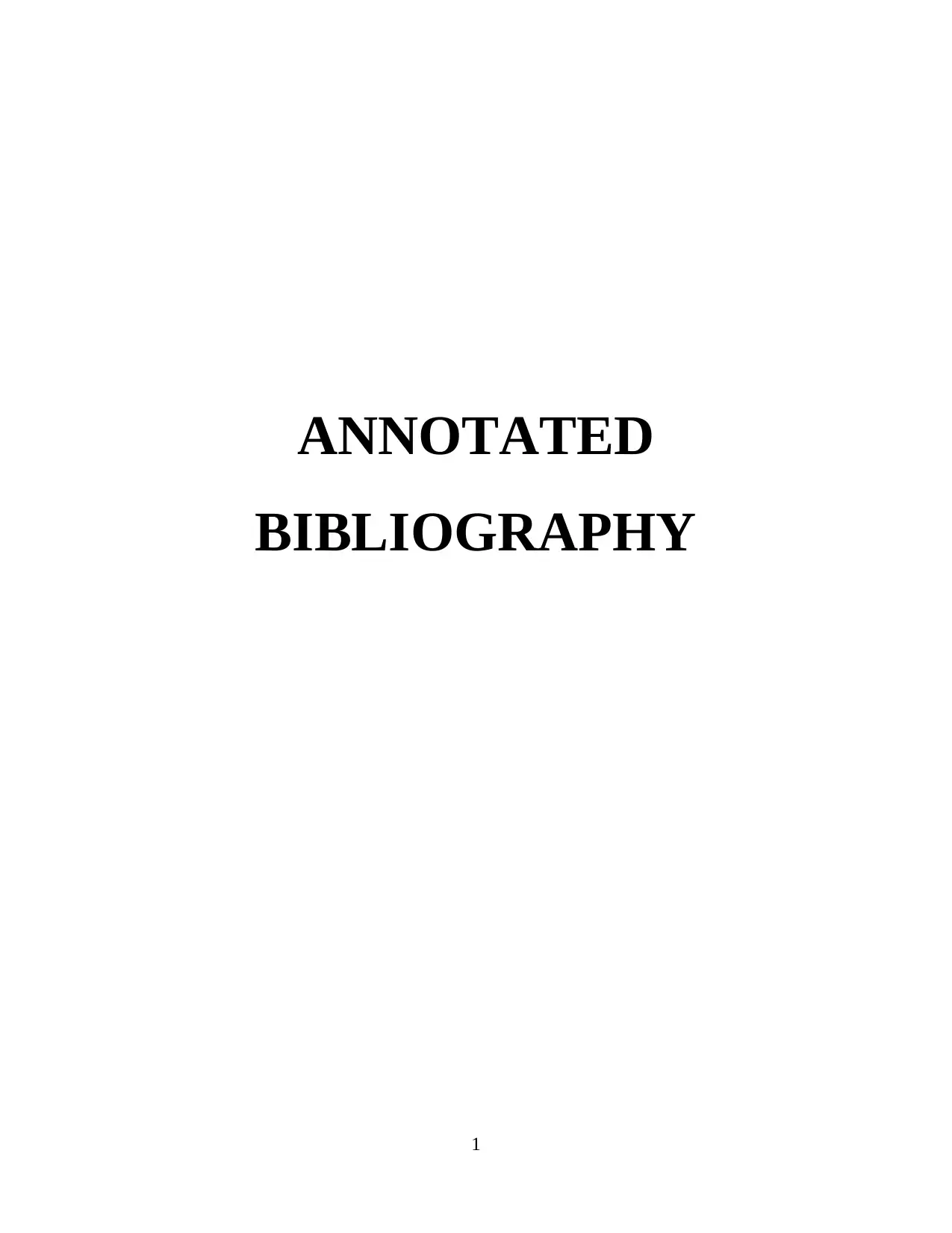
ANNOTATED
BIBLIOGRAPHY
1
BIBLIOGRAPHY
1
Paraphrase This Document
Need a fresh take? Get an instant paraphrase of this document with our AI Paraphraser
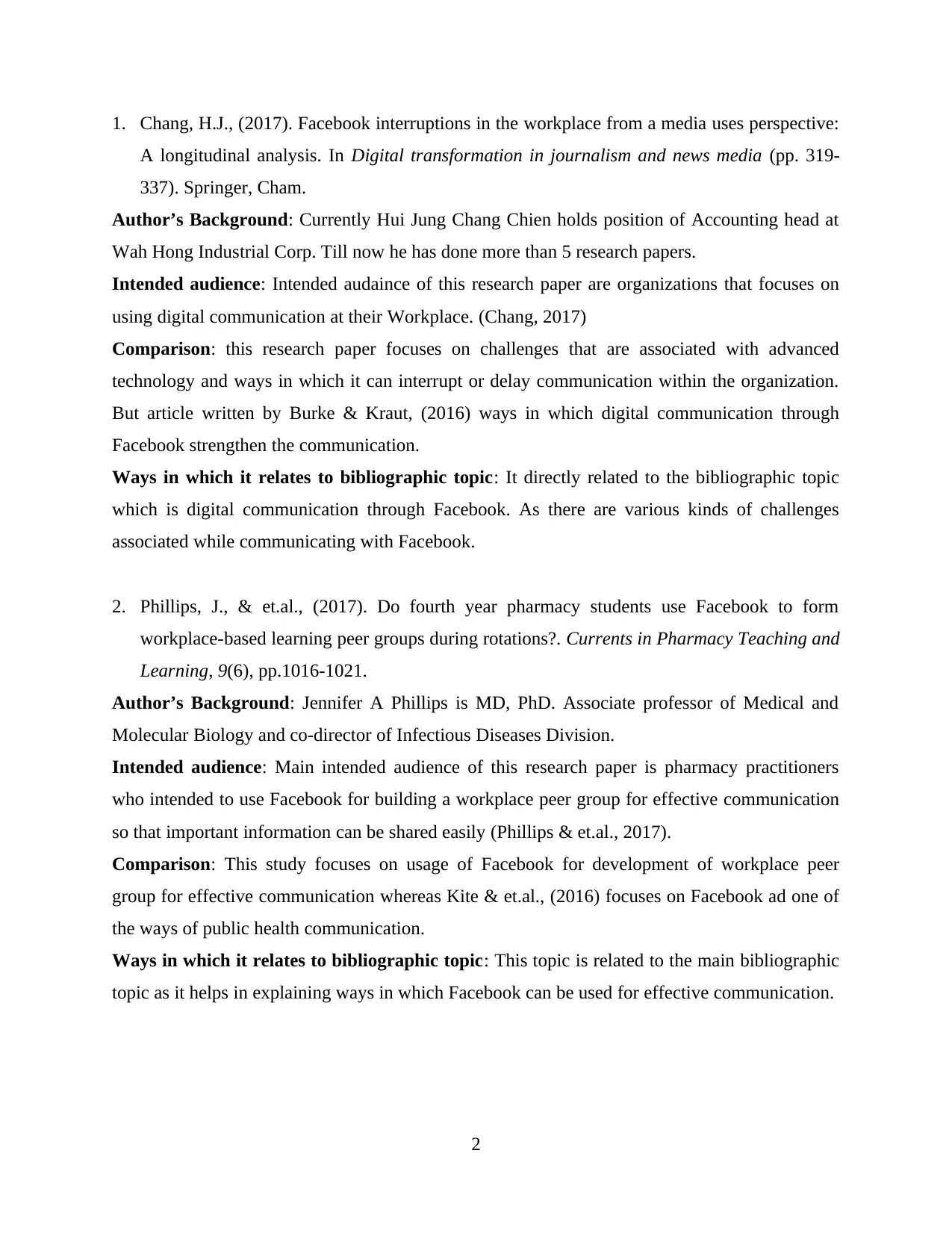
1. Chang, H.J., (2017). Facebook interruptions in the workplace from a media uses perspective:
A longitudinal analysis. In Digital transformation in journalism and news media (pp. 319-
337). Springer, Cham.
Author’s Background: Currently Hui Jung Chang Chien holds position of Accounting head at
Wah Hong Industrial Corp. Till now he has done more than 5 research papers.
Intended audience: Intended audaince of this research paper are organizations that focuses on
using digital communication at their Workplace. (Chang, 2017)
Comparison: this research paper focuses on challenges that are associated with advanced
technology and ways in which it can interrupt or delay communication within the organization.
But article written by Burke & Kraut, (2016) ways in which digital communication through
Facebook strengthen the communication.
Ways in which it relates to bibliographic topic: It directly related to the bibliographic topic
which is digital communication through Facebook. As there are various kinds of challenges
associated while communicating with Facebook.
2. Phillips, J., & et.al., (2017). Do fourth year pharmacy students use Facebook to form
workplace-based learning peer groups during rotations?. Currents in Pharmacy Teaching and
Learning, 9(6), pp.1016-1021.
Author’s Background: Jennifer A Phillips is MD, PhD. Associate professor of Medical and
Molecular Biology and co-director of Infectious Diseases Division.
Intended audience: Main intended audience of this research paper is pharmacy practitioners
who intended to use Facebook for building a workplace peer group for effective communication
so that important information can be shared easily (Phillips & et.al., 2017).
Comparison: This study focuses on usage of Facebook for development of workplace peer
group for effective communication whereas Kite & et.al., (2016) focuses on Facebook ad one of
the ways of public health communication.
Ways in which it relates to bibliographic topic: This topic is related to the main bibliographic
topic as it helps in explaining ways in which Facebook can be used for effective communication.
2
A longitudinal analysis. In Digital transformation in journalism and news media (pp. 319-
337). Springer, Cham.
Author’s Background: Currently Hui Jung Chang Chien holds position of Accounting head at
Wah Hong Industrial Corp. Till now he has done more than 5 research papers.
Intended audience: Intended audaince of this research paper are organizations that focuses on
using digital communication at their Workplace. (Chang, 2017)
Comparison: this research paper focuses on challenges that are associated with advanced
technology and ways in which it can interrupt or delay communication within the organization.
But article written by Burke & Kraut, (2016) ways in which digital communication through
Facebook strengthen the communication.
Ways in which it relates to bibliographic topic: It directly related to the bibliographic topic
which is digital communication through Facebook. As there are various kinds of challenges
associated while communicating with Facebook.
2. Phillips, J., & et.al., (2017). Do fourth year pharmacy students use Facebook to form
workplace-based learning peer groups during rotations?. Currents in Pharmacy Teaching and
Learning, 9(6), pp.1016-1021.
Author’s Background: Jennifer A Phillips is MD, PhD. Associate professor of Medical and
Molecular Biology and co-director of Infectious Diseases Division.
Intended audience: Main intended audience of this research paper is pharmacy practitioners
who intended to use Facebook for building a workplace peer group for effective communication
so that important information can be shared easily (Phillips & et.al., 2017).
Comparison: This study focuses on usage of Facebook for development of workplace peer
group for effective communication whereas Kite & et.al., (2016) focuses on Facebook ad one of
the ways of public health communication.
Ways in which it relates to bibliographic topic: This topic is related to the main bibliographic
topic as it helps in explaining ways in which Facebook can be used for effective communication.
2
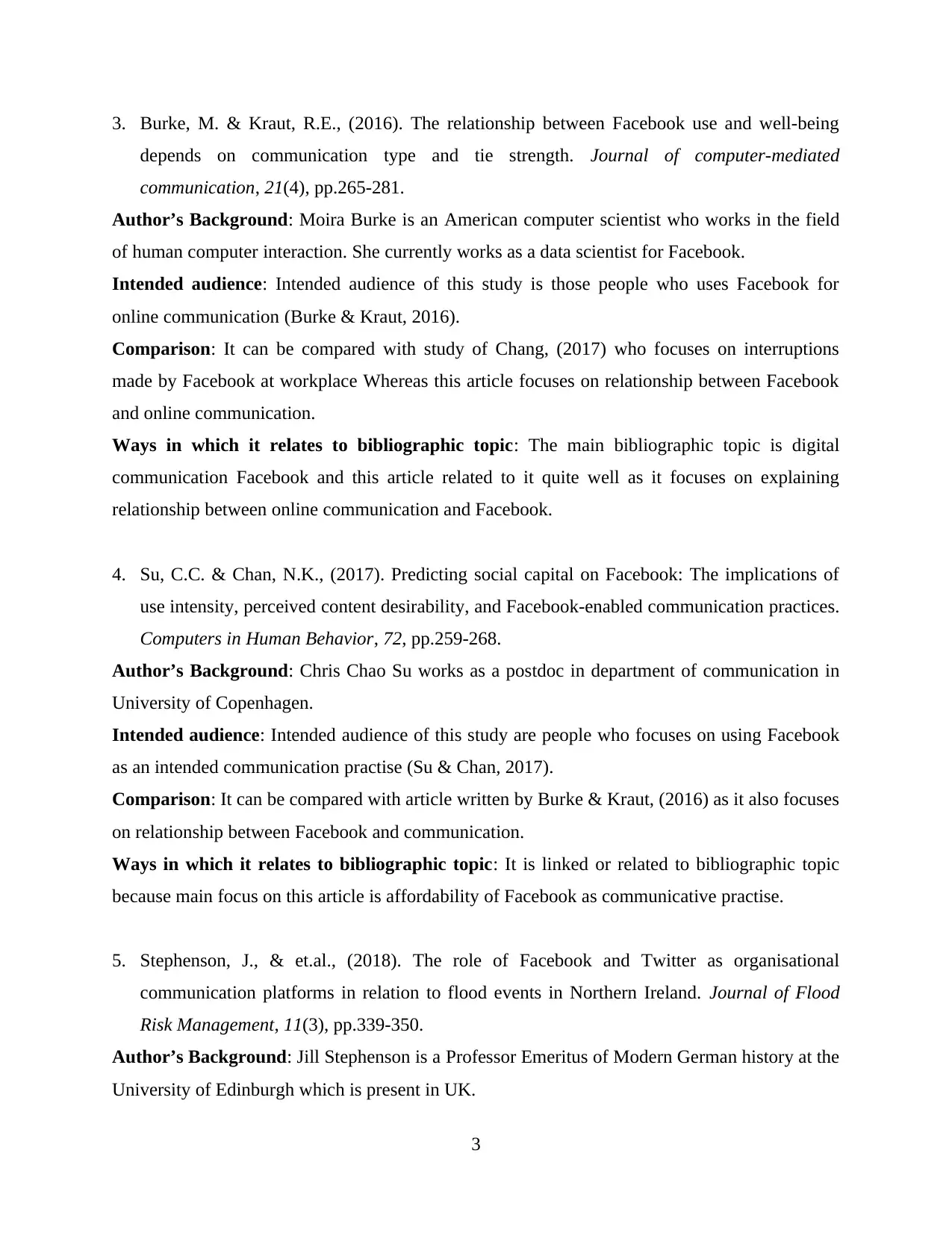
3. Burke, M. & Kraut, R.E., (2016). The relationship between Facebook use and well-being
depends on communication type and tie strength. Journal of computer-mediated
communication, 21(4), pp.265-281.
Author’s Background: Moira Burke is an American computer scientist who works in the field
of human computer interaction. She currently works as a data scientist for Facebook.
Intended audience: Intended audience of this study is those people who uses Facebook for
online communication (Burke & Kraut, 2016).
Comparison: It can be compared with study of Chang, (2017) who focuses on interruptions
made by Facebook at workplace Whereas this article focuses on relationship between Facebook
and online communication.
Ways in which it relates to bibliographic topic: The main bibliographic topic is digital
communication Facebook and this article related to it quite well as it focuses on explaining
relationship between online communication and Facebook.
4. Su, C.C. & Chan, N.K., (2017). Predicting social capital on Facebook: The implications of
use intensity, perceived content desirability, and Facebook-enabled communication practices.
Computers in Human Behavior, 72, pp.259-268.
Author’s Background: Chris Chao Su works as a postdoc in department of communication in
University of Copenhagen.
Intended audience: Intended audience of this study are people who focuses on using Facebook
as an intended communication practise (Su & Chan, 2017).
Comparison: It can be compared with article written by Burke & Kraut, (2016) as it also focuses
on relationship between Facebook and communication.
Ways in which it relates to bibliographic topic: It is linked or related to bibliographic topic
because main focus on this article is affordability of Facebook as communicative practise.
5. Stephenson, J., & et.al., (2018). The role of Facebook and Twitter as organisational
communication platforms in relation to flood events in Northern Ireland. Journal of Flood
Risk Management, 11(3), pp.339-350.
Author’s Background: Jill Stephenson is a Professor Emeritus of Modern German history at the
University of Edinburgh which is present in UK.
3
depends on communication type and tie strength. Journal of computer-mediated
communication, 21(4), pp.265-281.
Author’s Background: Moira Burke is an American computer scientist who works in the field
of human computer interaction. She currently works as a data scientist for Facebook.
Intended audience: Intended audience of this study is those people who uses Facebook for
online communication (Burke & Kraut, 2016).
Comparison: It can be compared with study of Chang, (2017) who focuses on interruptions
made by Facebook at workplace Whereas this article focuses on relationship between Facebook
and online communication.
Ways in which it relates to bibliographic topic: The main bibliographic topic is digital
communication Facebook and this article related to it quite well as it focuses on explaining
relationship between online communication and Facebook.
4. Su, C.C. & Chan, N.K., (2017). Predicting social capital on Facebook: The implications of
use intensity, perceived content desirability, and Facebook-enabled communication practices.
Computers in Human Behavior, 72, pp.259-268.
Author’s Background: Chris Chao Su works as a postdoc in department of communication in
University of Copenhagen.
Intended audience: Intended audience of this study are people who focuses on using Facebook
as an intended communication practise (Su & Chan, 2017).
Comparison: It can be compared with article written by Burke & Kraut, (2016) as it also focuses
on relationship between Facebook and communication.
Ways in which it relates to bibliographic topic: It is linked or related to bibliographic topic
because main focus on this article is affordability of Facebook as communicative practise.
5. Stephenson, J., & et.al., (2018). The role of Facebook and Twitter as organisational
communication platforms in relation to flood events in Northern Ireland. Journal of Flood
Risk Management, 11(3), pp.339-350.
Author’s Background: Jill Stephenson is a Professor Emeritus of Modern German history at the
University of Edinburgh which is present in UK.
3
⊘ This is a preview!⊘
Do you want full access?
Subscribe today to unlock all pages.

Trusted by 1+ million students worldwide
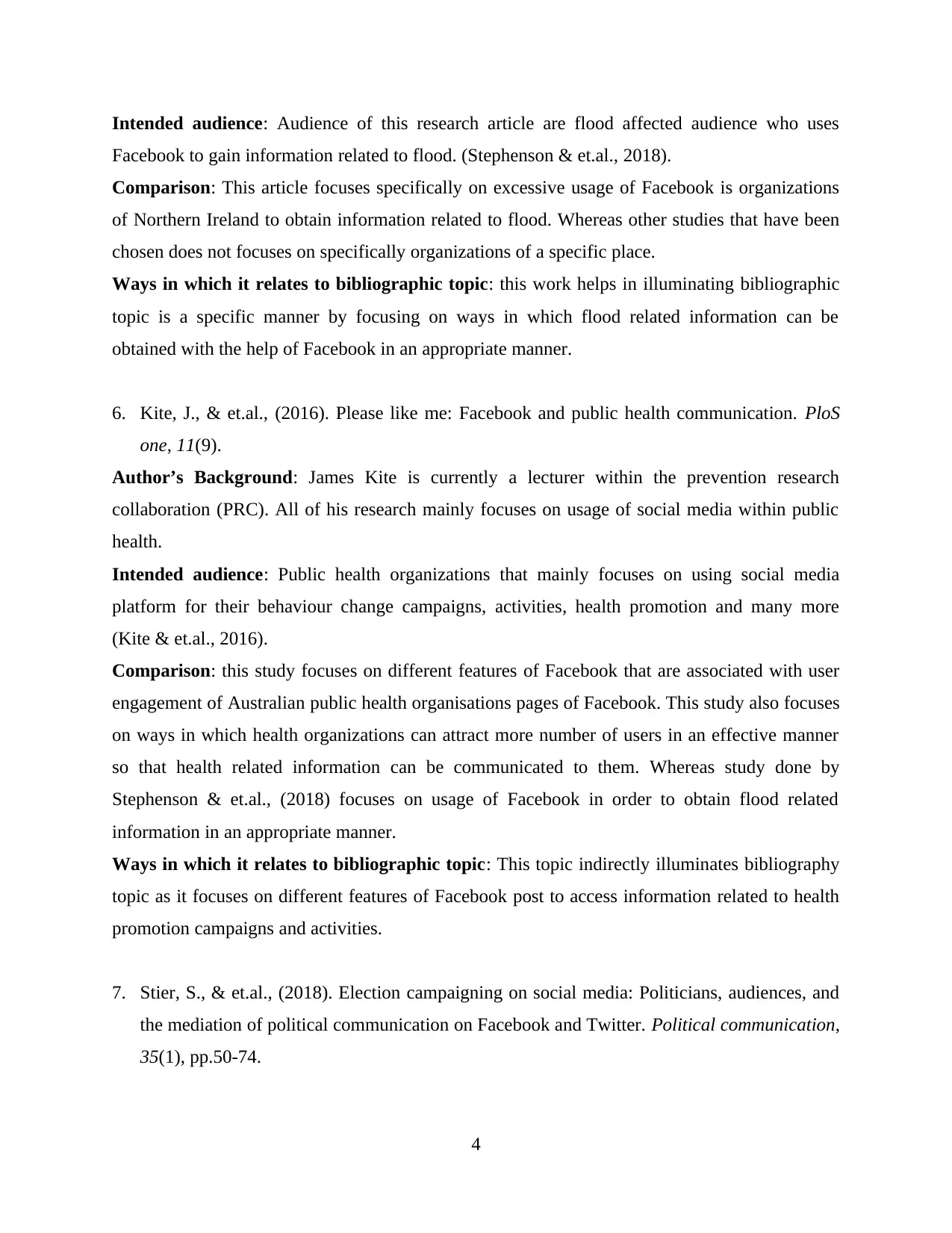
Intended audience: Audience of this research article are flood affected audience who uses
Facebook to gain information related to flood. (Stephenson & et.al., 2018).
Comparison: This article focuses specifically on excessive usage of Facebook is organizations
of Northern Ireland to obtain information related to flood. Whereas other studies that have been
chosen does not focuses on specifically organizations of a specific place.
Ways in which it relates to bibliographic topic: this work helps in illuminating bibliographic
topic is a specific manner by focusing on ways in which flood related information can be
obtained with the help of Facebook in an appropriate manner.
6. Kite, J., & et.al., (2016). Please like me: Facebook and public health communication. PloS
one, 11(9).
Author’s Background: James Kite is currently a lecturer within the prevention research
collaboration (PRC). All of his research mainly focuses on usage of social media within public
health.
Intended audience: Public health organizations that mainly focuses on using social media
platform for their behaviour change campaigns, activities, health promotion and many more
(Kite & et.al., 2016).
Comparison: this study focuses on different features of Facebook that are associated with user
engagement of Australian public health organisations pages of Facebook. This study also focuses
on ways in which health organizations can attract more number of users in an effective manner
so that health related information can be communicated to them. Whereas study done by
Stephenson & et.al., (2018) focuses on usage of Facebook in order to obtain flood related
information in an appropriate manner.
Ways in which it relates to bibliographic topic: This topic indirectly illuminates bibliography
topic as it focuses on different features of Facebook post to access information related to health
promotion campaigns and activities.
7. Stier, S., & et.al., (2018). Election campaigning on social media: Politicians, audiences, and
the mediation of political communication on Facebook and Twitter. Political communication,
35(1), pp.50-74.
4
Facebook to gain information related to flood. (Stephenson & et.al., 2018).
Comparison: This article focuses specifically on excessive usage of Facebook is organizations
of Northern Ireland to obtain information related to flood. Whereas other studies that have been
chosen does not focuses on specifically organizations of a specific place.
Ways in which it relates to bibliographic topic: this work helps in illuminating bibliographic
topic is a specific manner by focusing on ways in which flood related information can be
obtained with the help of Facebook in an appropriate manner.
6. Kite, J., & et.al., (2016). Please like me: Facebook and public health communication. PloS
one, 11(9).
Author’s Background: James Kite is currently a lecturer within the prevention research
collaboration (PRC). All of his research mainly focuses on usage of social media within public
health.
Intended audience: Public health organizations that mainly focuses on using social media
platform for their behaviour change campaigns, activities, health promotion and many more
(Kite & et.al., 2016).
Comparison: this study focuses on different features of Facebook that are associated with user
engagement of Australian public health organisations pages of Facebook. This study also focuses
on ways in which health organizations can attract more number of users in an effective manner
so that health related information can be communicated to them. Whereas study done by
Stephenson & et.al., (2018) focuses on usage of Facebook in order to obtain flood related
information in an appropriate manner.
Ways in which it relates to bibliographic topic: This topic indirectly illuminates bibliography
topic as it focuses on different features of Facebook post to access information related to health
promotion campaigns and activities.
7. Stier, S., & et.al., (2018). Election campaigning on social media: Politicians, audiences, and
the mediation of political communication on Facebook and Twitter. Political communication,
35(1), pp.50-74.
4
Paraphrase This Document
Need a fresh take? Get an instant paraphrase of this document with our AI Paraphraser
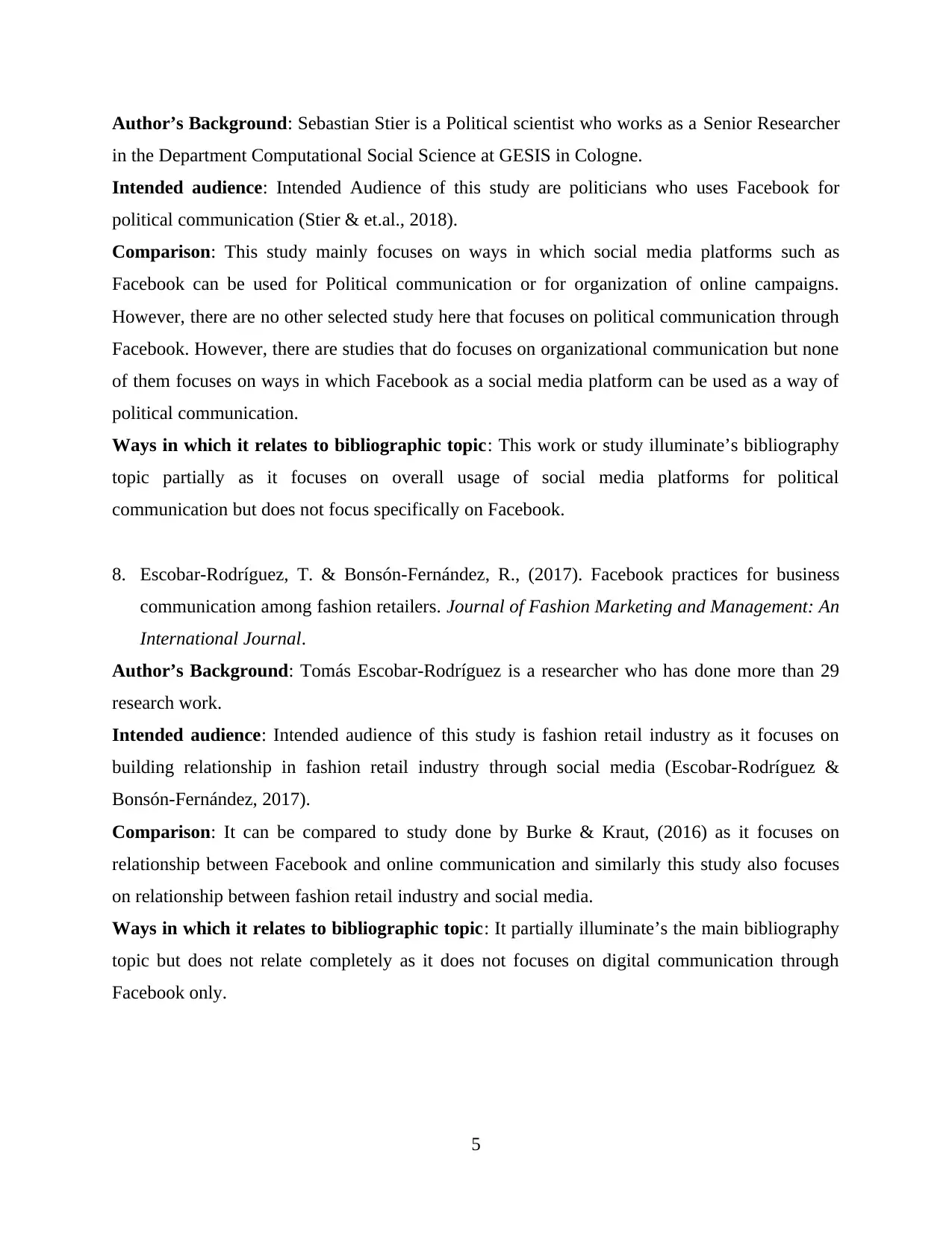
Author’s Background: Sebastian Stier is a Political scientist who works as a Senior Researcher
in the Department Computational Social Science at GESIS in Cologne.
Intended audience: Intended Audience of this study are politicians who uses Facebook for
political communication (Stier & et.al., 2018).
Comparison: This study mainly focuses on ways in which social media platforms such as
Facebook can be used for Political communication or for organization of online campaigns.
However, there are no other selected study here that focuses on political communication through
Facebook. However, there are studies that do focuses on organizational communication but none
of them focuses on ways in which Facebook as a social media platform can be used as a way of
political communication.
Ways in which it relates to bibliographic topic: This work or study illuminate’s bibliography
topic partially as it focuses on overall usage of social media platforms for political
communication but does not focus specifically on Facebook.
8. Escobar-Rodríguez, T. & Bonsón-Fernández, R., (2017). Facebook practices for business
communication among fashion retailers. Journal of Fashion Marketing and Management: An
International Journal.
Author’s Background: Tomás Escobar-Rodríguez is a researcher who has done more than 29
research work.
Intended audience: Intended audience of this study is fashion retail industry as it focuses on
building relationship in fashion retail industry through social media (Escobar-Rodríguez &
Bonsón-Fernández, 2017).
Comparison: It can be compared to study done by Burke & Kraut, (2016) as it focuses on
relationship between Facebook and online communication and similarly this study also focuses
on relationship between fashion retail industry and social media.
Ways in which it relates to bibliographic topic: It partially illuminate’s the main bibliography
topic but does not relate completely as it does not focuses on digital communication through
Facebook only.
5
in the Department Computational Social Science at GESIS in Cologne.
Intended audience: Intended Audience of this study are politicians who uses Facebook for
political communication (Stier & et.al., 2018).
Comparison: This study mainly focuses on ways in which social media platforms such as
Facebook can be used for Political communication or for organization of online campaigns.
However, there are no other selected study here that focuses on political communication through
Facebook. However, there are studies that do focuses on organizational communication but none
of them focuses on ways in which Facebook as a social media platform can be used as a way of
political communication.
Ways in which it relates to bibliographic topic: This work or study illuminate’s bibliography
topic partially as it focuses on overall usage of social media platforms for political
communication but does not focus specifically on Facebook.
8. Escobar-Rodríguez, T. & Bonsón-Fernández, R., (2017). Facebook practices for business
communication among fashion retailers. Journal of Fashion Marketing and Management: An
International Journal.
Author’s Background: Tomás Escobar-Rodríguez is a researcher who has done more than 29
research work.
Intended audience: Intended audience of this study is fashion retail industry as it focuses on
building relationship in fashion retail industry through social media (Escobar-Rodríguez &
Bonsón-Fernández, 2017).
Comparison: It can be compared to study done by Burke & Kraut, (2016) as it focuses on
relationship between Facebook and online communication and similarly this study also focuses
on relationship between fashion retail industry and social media.
Ways in which it relates to bibliographic topic: It partially illuminate’s the main bibliography
topic but does not relate completely as it does not focuses on digital communication through
Facebook only.
5
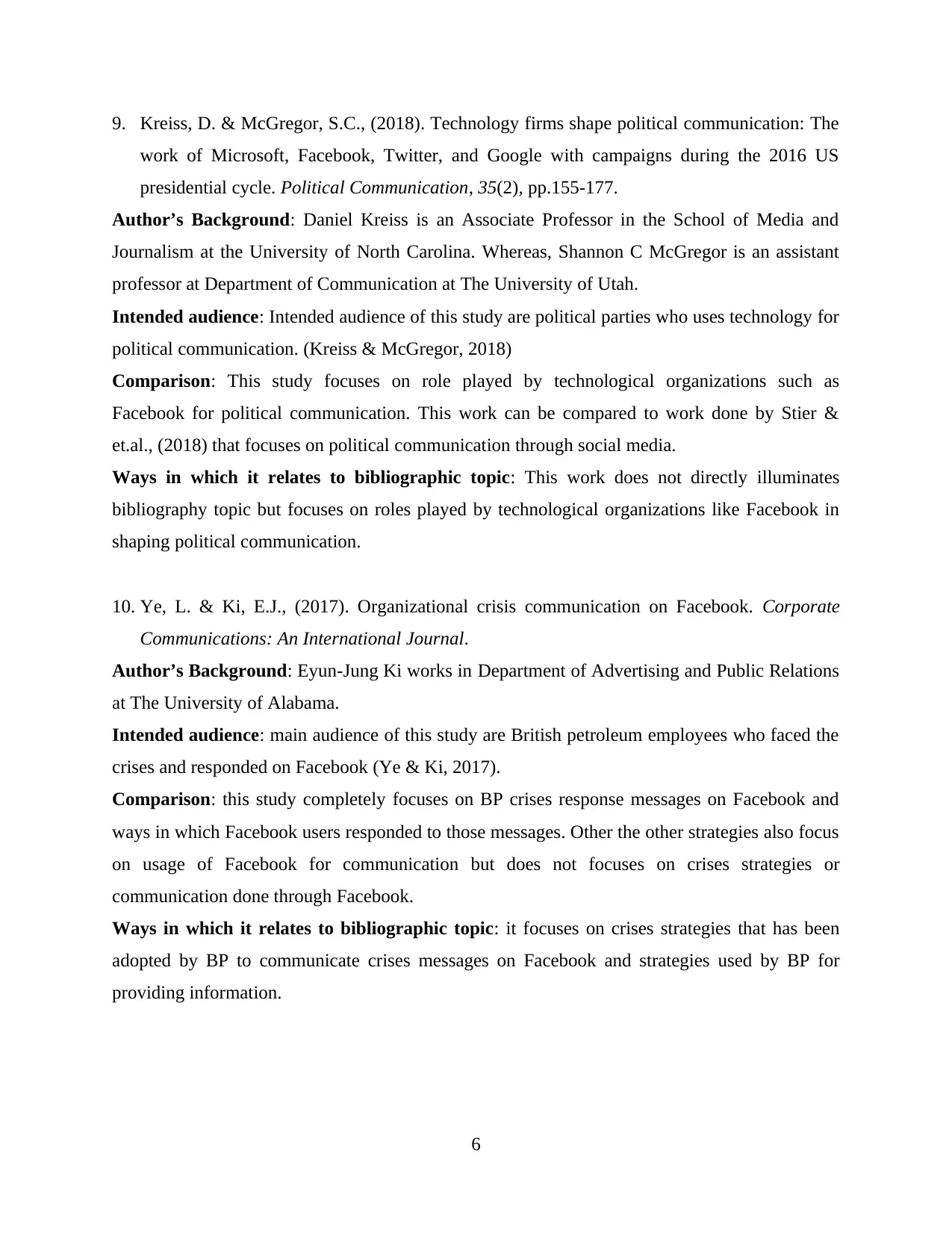
9. Kreiss, D. & McGregor, S.C., (2018). Technology firms shape political communication: The
work of Microsoft, Facebook, Twitter, and Google with campaigns during the 2016 US
presidential cycle. Political Communication, 35(2), pp.155-177.
Author’s Background: Daniel Kreiss is an Associate Professor in the School of Media and
Journalism at the University of North Carolina. Whereas, Shannon C McGregor is an assistant
professor at Department of Communication at The University of Utah.
Intended audience: Intended audience of this study are political parties who uses technology for
political communication. (Kreiss & McGregor, 2018)
Comparison: This study focuses on role played by technological organizations such as
Facebook for political communication. This work can be compared to work done by Stier &
et.al., (2018) that focuses on political communication through social media.
Ways in which it relates to bibliographic topic: This work does not directly illuminates
bibliography topic but focuses on roles played by technological organizations like Facebook in
shaping political communication.
10. Ye, L. & Ki, E.J., (2017). Organizational crisis communication on Facebook. Corporate
Communications: An International Journal.
Author’s Background: Eyun-Jung Ki works in Department of Advertising and Public Relations
at The University of Alabama.
Intended audience: main audience of this study are British petroleum employees who faced the
crises and responded on Facebook (Ye & Ki, 2017).
Comparison: this study completely focuses on BP crises response messages on Facebook and
ways in which Facebook users responded to those messages. Other the other strategies also focus
on usage of Facebook for communication but does not focuses on crises strategies or
communication done through Facebook.
Ways in which it relates to bibliographic topic: it focuses on crises strategies that has been
adopted by BP to communicate crises messages on Facebook and strategies used by BP for
providing information.
6
work of Microsoft, Facebook, Twitter, and Google with campaigns during the 2016 US
presidential cycle. Political Communication, 35(2), pp.155-177.
Author’s Background: Daniel Kreiss is an Associate Professor in the School of Media and
Journalism at the University of North Carolina. Whereas, Shannon C McGregor is an assistant
professor at Department of Communication at The University of Utah.
Intended audience: Intended audience of this study are political parties who uses technology for
political communication. (Kreiss & McGregor, 2018)
Comparison: This study focuses on role played by technological organizations such as
Facebook for political communication. This work can be compared to work done by Stier &
et.al., (2018) that focuses on political communication through social media.
Ways in which it relates to bibliographic topic: This work does not directly illuminates
bibliography topic but focuses on roles played by technological organizations like Facebook in
shaping political communication.
10. Ye, L. & Ki, E.J., (2017). Organizational crisis communication on Facebook. Corporate
Communications: An International Journal.
Author’s Background: Eyun-Jung Ki works in Department of Advertising and Public Relations
at The University of Alabama.
Intended audience: main audience of this study are British petroleum employees who faced the
crises and responded on Facebook (Ye & Ki, 2017).
Comparison: this study completely focuses on BP crises response messages on Facebook and
ways in which Facebook users responded to those messages. Other the other strategies also focus
on usage of Facebook for communication but does not focuses on crises strategies or
communication done through Facebook.
Ways in which it relates to bibliographic topic: it focuses on crises strategies that has been
adopted by BP to communicate crises messages on Facebook and strategies used by BP for
providing information.
6
⊘ This is a preview!⊘
Do you want full access?
Subscribe today to unlock all pages.

Trusted by 1+ million students worldwide
1 out of 6
Your All-in-One AI-Powered Toolkit for Academic Success.
+13062052269
info@desklib.com
Available 24*7 on WhatsApp / Email
![[object Object]](/_next/static/media/star-bottom.7253800d.svg)
Unlock your academic potential
Copyright © 2020–2025 A2Z Services. All Rights Reserved. Developed and managed by ZUCOL.
